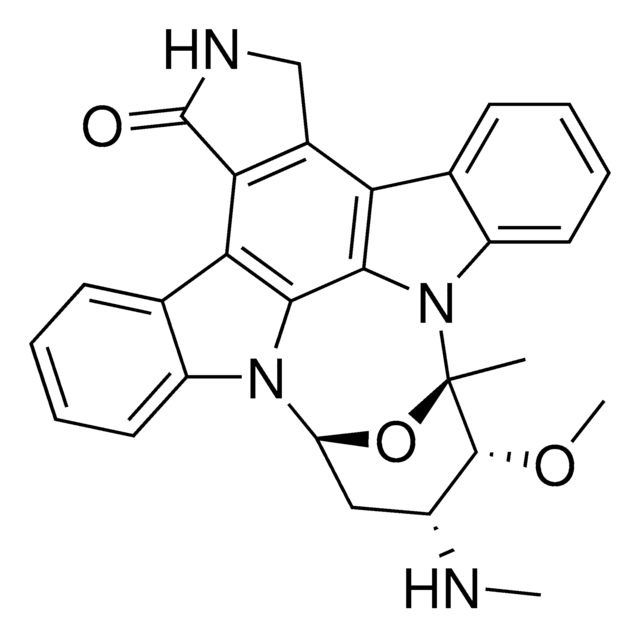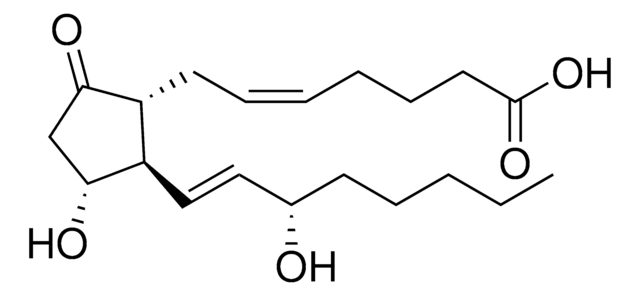S7076
SB 202190 -monohydrochlorid Hydrat
≥98% (HPLC), solid, p38 MAP kinase inhibitor
Synonym(e):
4-(4-Fluorphenyl)-2-(4-hydroxyphenyl)-5-(4-pyridyl)-1H-imidazol -monohydrochlorid Hydrat, 4-[4-(4-Fluorphenyl)-5-(4-pyridinyl)-1H-imidazol-2-yl]phenol -monohydrochlorid Hydrat
About This Item
Empfohlene Produkte
product name
SB 202190 -monohydrochlorid Hydrat, ≥98% (HPLC)
Qualitätsniveau
Assay
≥98% (HPLC)
Form
solid
Lagerbedingungen
desiccated
Farbe
white to beige
Löslichkeit
DMSO: ≥12 mg/mL
Ersteller
GlaxoSmithKline
Lagertemp.
2-8°C
SMILES String
O.Cl.Oc1ccc(cc1)-c2nc(-c3ccc(F)cc3)c([nH]2)-c4ccncc4
InChI
1S/C20H14FN3O.ClH.H2O/c21-16-5-1-13(2-6-16)18-19(14-9-11-22-12-10-14)24-20(23-18)15-3-7-17(25)8-4-15;;/h1-12,25H,(H,23,24);1H;1H2
InChIKey
CZZOICWZVYZUNP-UHFFFAOYSA-N
Anwendung
Biochem./physiol. Wirkung
Leistungsmerkmale und Vorteile
Signalwort
Warning
H-Sätze
Gefahreneinstufungen
Eye Irrit. 2 - Skin Irrit. 2 - STOT SE 3
Zielorgane
Respiratory system
Lagerklassenschlüssel
11 - Combustible Solids
WGK
WGK 3
Flammpunkt (°F)
Not applicable
Flammpunkt (°C)
Not applicable
Analysenzertifikate (COA)
Suchen Sie nach Analysenzertifikate (COA), indem Sie die Lot-/Chargennummer des Produkts eingeben. Lot- und Chargennummern sind auf dem Produktetikett hinter den Wörtern ‘Lot’ oder ‘Batch’ (Lot oder Charge) zu finden.
Besitzen Sie dieses Produkt bereits?
In der Dokumentenbibliothek finden Sie die Dokumentation zu den Produkten, die Sie kürzlich erworben haben.
Kunden haben sich ebenfalls angesehen
Artikel
The mitogen-activated protein kinase (MAPK) family consists of both stress activated (SAPK) and mitogen-activated (MAPK) protein kinases. They form a network of signal transduction cascades that mediate cellular responses to a diverse range of stimuli, including growth factors, chemical or osmotic stress, irradiation, bacterial infection and proinflammatory cytokines.
rganoid culture products to generate tissue and stem cell derived 3D brain, intestinal, gut, lung and cancer tumor organoid models.
Unser Team von Wissenschaftlern verfügt über Erfahrung in allen Forschungsbereichen einschließlich Life Science, Materialwissenschaften, chemischer Synthese, Chromatographie, Analytik und vielen mehr..
Setzen Sie sich mit dem technischen Dienst in Verbindung.

![[Leu15]-Gastrin I Human ≥95% (HPLC)](/deepweb/assets/sigmaaldrich/product/structures/153/342/d4cb3dd7-13f1-46cf-8d1f-3907a5de7a83/640/d4cb3dd7-13f1-46cf-8d1f-3907a5de7a83.png)






